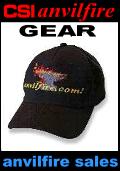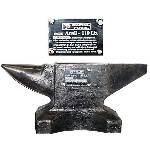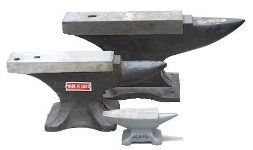|
| |||||||||
| |||||||
| |||||||
| |||||||
|
| ||||||
|
| ||||||
| |||||||
| |||||||
| |||||||
| |||||||
| |||||||
| |||||||
| |||||||
| |||||||
| |||||||
| |||||||
| |||||||
| |||||||
| |||||||

Blacksmithing and metalworking questions answered. | |||||||


 Click for Detail |
110# Russian Anvil
Product Report by Robert Nichols AKA quenchcrack September 10, 2002 | |||
|
-GURU |
This is a report on the 110 pound (50 kg) Russian cast steel anvil currently being sold by Harbor Freight.
There has been a lot of buzz about theses anvils on various Internet forums and we thought we would clear the air.
These NEW anvils are currently being sold at the amazing price of $1/pound or less delivered in the U.S. This is significantly lower than the low cost Czech imports or even used beat up anvils. Carefully note that these ARE NOT the same as the similar looking Chinese cast iron "Anvil Shaped Objects" also sold by Harbor Freight. |
|||
|
|
||||
|
QC |
The 110# Russian cast steel anvil now being offered by Harbor Freight has generated a lot of interest in the Blacksmithing community. The following is a review by a hobbyist who bought one. The anvil came in an open wooden crate that, for the most part, kept it confined sufficiently to prevent any shipping damage. Once out of the crate, it was obvious, this was an ugly anvil |
|||
 Figure 2 Click for Detail |
This anvil is like most things from the former Soviet Union: blocky and graceless. The ridge running down the horn is the parting line, the place where the cope and the drag meet (Fig. 2). Not much effort was spent dressing up the parting lines on this casting. |
|||
 Figure 3 Click for Detail |
I noticed a line, under the face, that suggested that this anvil had a tool steel face cast into it(Fig. 3) This turned out not to be the case. As you can see, Russian steel foundry technology is not represented here at its best. I have named this anvil “The Toad” for obvious reasons. |
|||
 Figure 4 Click for Detail |
The face of the anvil bore the milling marks (Fig. 4) that left the surface more like a fine file. Those had to be ground off, too. I took up my 4.5” grinder and went to work on the horn and the face. |
|||
 Figure 5 Click for Detail |
After about 20 minutes, they looked like this (Fig. 5). | |||
 Figure 6 Click for Detail |
Certainly a better finish but the shape still looks like a ducks bill. It will take a lot more work on the grinder to get this horn to a true round shape. The horn is designed for castability, not the needs of the smith (Fig. 6). |
|||
|
QC |
I tried the hammer drop test and, while the anvil had a high pitched ring, the rebound was not spectacular. I would estimate it at between 50% and 75%. |
|||
 Figure 7 Click for Detail |
Grinding with the belt grinder will remove the swirls from the disk grinder | |||
 Figure 8 Click for Detail |
The grinder quickly removed the milling marks. Grinding also showed some flaws around the hardy hole (Fig. 8). | |||
|
QC |
I decided not to grind these out, as they probably do not pose a potential problem worth all of the effort that would be expended removing them. A few surface flaws remained in the side of the horn after grinding and these were also left in place. The hardy was a sloppy 1-1/8” and my hardy tools did not fit well in this hole. NOTE: This is probably a 28-29mm hardy hole. I would recommend a heavier chamfer or radius on the hardy hole so that the corners do not interfere with inside corner radii on tools. -guru |
|||
 Figure 9 Click for Detail |
I then took to the face with a belt sander, 100 grit, and smoothed out the grinding marks (Fig. 9). |
|||
 Figure 10 Click for Detail |
The anvil face and horn were now reasonably smooth (Fig. 10) and it was time to fire the forge. I chose to work on a RR spike tomahawk head because it was a fair sized cross section to pound on. I did not have a proper stump to mount the anvil on so it was put on the 2”x 6” A-frame stand that held my 70# farriers anvil. I removed the top 2”x 6” and replaced it with a 2” X 8”, donated by a local construction company who was building a house down the street. |
|||
|
QC |
Once the anvil was placed on the frame, I bolted it down with 4 each ½” lag screws and 2” washers. This is a temporary mount but was sufficient to reduce the ring to a heavy thud. The stand stood its ground through the pounding. | |||
 Figure 11 Click for Detail |
Once the spike was hot, I went at it with a 2# cross pein hammer. After several heats and working the hawk blade with the pi en end, I made an errant blow, not a full hit but I missed the work piece and hit the face. It left a mark (Fig. 11). Later, a second blow missed with similar results. Clearly, the face on this anvil is not fully hardened. I would estimate the hardness at between Rc 35 and 40. The anvil stood up well under heavy blows, as long as the blows hit the hot steel. It did not ring appreciably when struck. |
|||
|
QC |
I may spend more time on this anvil and grind the horn to a better cone-shape. I may also grind the surface down so that it does not look like a toad’s skin. This will not make it perform better but it will certainly look better! Ok, here’s the summary.
|
|||
|
QC |
REBOUND TEST: Using a 1" steel ball and the method described
here.
The Russian anvil rebound was between 50 and 65%. The 50% was in the area where the tool marks remained from my poor hammer control. Clearly, the face hardness is a bit spotty. I did a similar series of tests on my "Smith Steel Casting Co." anvil and got an amazing 80%-90%! This is only a 70 # farrier anvil but after using it for several months, there is still not a mark on the face. |
|||
|
QC |
METALLURGICAL REPORT:
A 3/16" hole was drilled in the bottom of the anvil using a hand power drill. The chips curled like steel. I had enough drillings to run a carbon content on the anvil. I told the guy in the spectro lab that I would estimate a carbon range around .40 and it came back at .38. To run a full analysis I needed to go drill out another 33 grams and that did not appeal to me. At any rate, the carbon is high enough to quench out at Rc 55 with a perfect quench. In practice, I would not expect to exceed 45 with this mass. You might get a small improvement by flame hardening it but it would take a while and a BIG rosebud. NOTE: Flame hardening requires heating to a red heat and quenching with water. To to a good job flame hardening an anvil you would need a multi-tip torch arrangement so that you heat the full witdth of the face and a running water source just behind the flame and separated by a guard. This setup would probably need to be motorized in order to achieve an even heat and quench across the length of the anvil. This is also done on an uphill slope so that the water quenches and runs away from the flame. An expensive operation. Yes, I have thought about this more than once. -GURU |
|||
 Figure 13 Click for Detail |
Another photo of an owner dressed Russian HF anvil This is a picture of another Russian anvil sent to me by someone who saw this review. He put a lot of work into the horn and it still looks like the bow of a Russian submarine! |
|||
|
|
||||
 Figure 12 Click for Detail |
We have reported on Russian anvils in the past (anvilfire NEWS, Camp Fenby 1998). Figure 12 shows a larger Russian anvil of roughly the same pattern. This anvil was bought from an East Coast farrier supply by Bruce Blackistone. |
|||
|
-GURU |
This anvil was well finished and the horn properly shaped. The face is hard enough that it has survived use by many armature smiths invited to Bruce's shop during Longship Company workshops and their annual Camp Fenby event. This shows that not all Russian anvils are soft or poorly shaped. |
|||
 Figure 14 Click for Detail |
"NOT CHINESE ?", KING LA CALIF, Black Beauty Anvils We have had some impact on ebay. Dealers now refuse to identify where their anvils are manufactured, some making up brand names. At least one is selling unlabled anvils that are clearly marked Made in China by reputable dealers (see below). Another gives the California importer's name as evidence that they are not Chinese imports. ???? Harbor Freight carries the Russian of and on and does not list it in their catalogs. Russians and copies of Russians are now being sold on ebay. |
|||
 Figure 15 Click for Detail |
"NOT CHINESE ?", with Diagonal Chinese Hardy Holes A major difference in the new crop (as of 2004) of these anvils is the diagonal hardy hole. This was NOT a feature of the anvil reviewed above. Prior to these the only place this was seen was on small junk Chinese made anvils. The sellers refuse to name the place of origin so we can only guess. |
|||
|
-GURU |
This feature is bad from both a use and engineering reasons.
The diagonal hole results in two points of stress concentration at a highly stressed location on the anvil.
Turning the hole diagonally increases the amount of material removed by the hole by 40%. NO anvil designer with any sense would do this.
However, a pattern maker copying anothers design and trying to make it cheaper and easier to produce would do this.
There are also serious usability issues. Standard hardy tools are made to be used along and perpendicular to the anvil. As smiths we learn to use them on one axis or the other. Changing this goes against hundreds of years of tradition and intelligent anvil design. |
|||
|
-GURU |
 These ASO's have a very distinctive look but many are cast from better patterns, including old forged steel anvils. There are also ASO's in the same pattern as Russian anvils above. Buyer beware! Although the Russian anvil reported on here is soft, it is very tough steel rather than cast iron and should not crack, chip or break from use as will a cast iron anvil. W A R N I N G! A few months after posting this review there were Chinese ASO's the exact same pattern as the Russian being sold on ebay. Unscrupulous dealers were claiming they were cast steel. And one referred customers to this article! THESE ARE JUNK CAST IRON ASO's, frauds! W A R N I N G! "CENTRAL FORGE" as shown on the label of the above anvil IS NOT the manufacturer. It is an importers "house brand" and means absolutely NOTHING. Cast iron Chinese ASO's are showing up all over the place with this label. W A R N I N G! At least one ebay dealer used our copyrighted images of the FINISHED anvil from this review (Figure 7) as well as stolen text to sell anvils on ebay. They were NOT photos of the product he was selling! Part of his scam included having a "buy now" price twice the normal resale price and a "flat" non refundable shipping that included much of his profit. This unscrupulous dealer was confronted and had to be reported to ebay because he claimed the images were first "his", then "common images from the net". Days later he showed up under a different user ID selling anvils he just happened to "find" in a house he bought. This person is an unapologetic liar and a thief. THINK before you do business on ebay. W A R N I N G! Yet ANOTHER ebay dealer polished up ONE anvil and was using photos of it to sell unfinished versions. You had to carefully read and re-read all the ad to find the disclaimer as a buried aside comment. W A R N I N G! One of these same dealers above is now declaring his anvils These are the Russian as described in this article. The reason that he does not want to state where the anvil is manufactured is that people searching for "russian anvil" would find this article. |
|||
|
|
References and Links
|
|||
